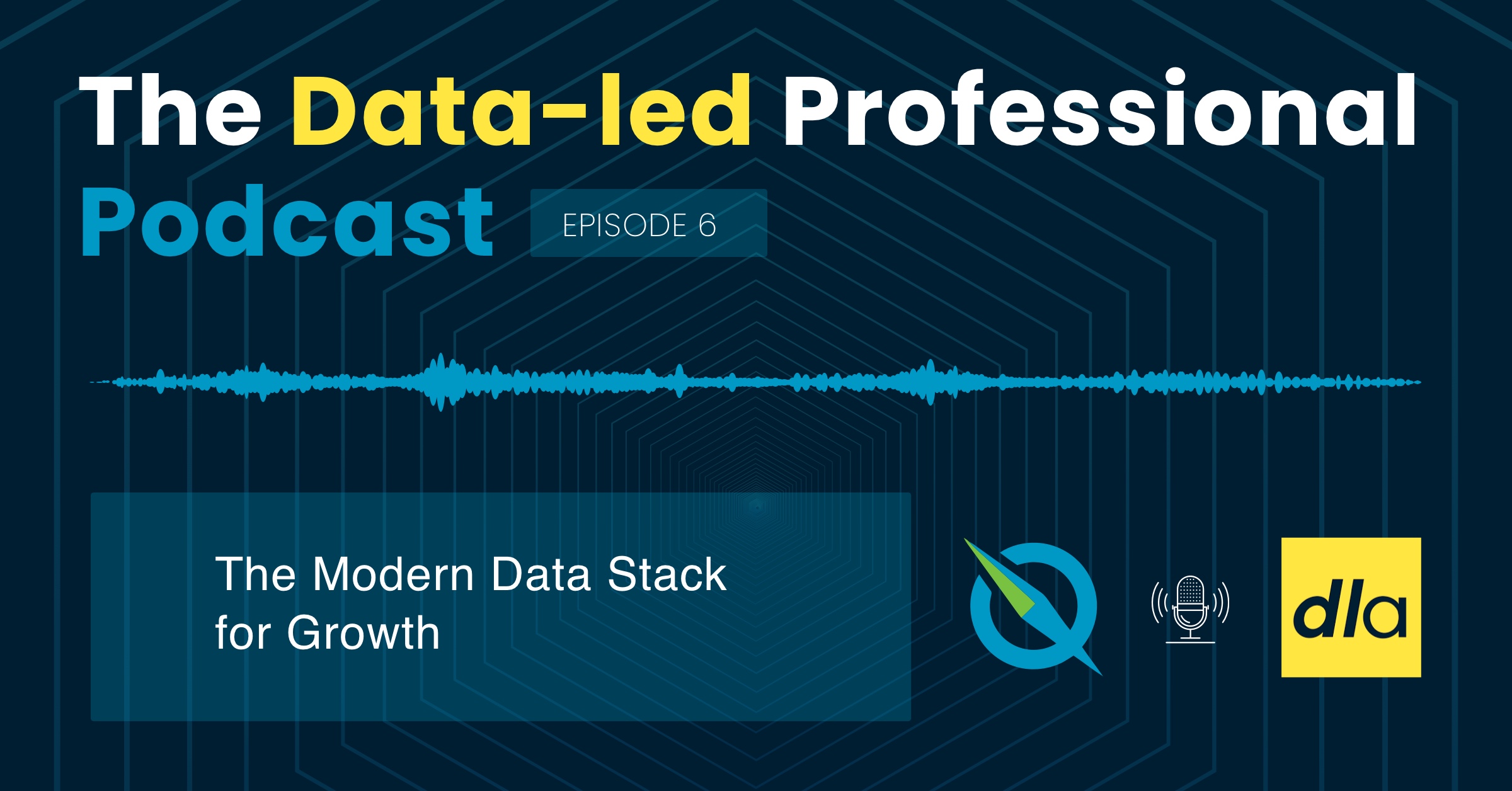The core components and the evolution of the tools that make up the modern data stack for growth
In this week’s episode, join hosts Claudiu Murariu, CEO and Co-Founder of InnerTrends, and Arpit Choudhury, Founder of Data-led Academy, as they break down the modern data stack for growth, its core components, and the evolution of the tools that make up the modern data stack for growth.
Having a data stack for growth will not only enable you to gather insights into customer behavior, but take those insights one step further and enable customer experiences through active engagement.
Subscribe on your favorite streaming platform for more episodes:
Listen on Apple Podcasts Listen on Spotify Listen on Google Podcasts Listen on StitcherWhat is the modern data stack for growth?
[A]: The term modern data stack, or MDS, is becoming really popular. When anybody refers to the modern data stack, they are actually referring to the modern data stack for analytics.
There are four core layers of the modern data stack for analytics:
- Data Collection or Ingestion
- Data Warehousing and Transformation
- Data Analysis
- Data Activation
With MDS for analytics it’s pretty straightforward. There are these four very distinct layers, and then there are certain tools under each layer. Something similar for growth professionals should make sense.
The idea behind the modern data stack for growth is: just as there is a data stack for analytics, which helps data analysts and data engineers, there should also be a modern data stack for growth, which helps growth professionals.
[C]: A data stack for analytics always included data collection, warehousing, transformation, analysis, and activation. But what happened recently is amazing new tools started getting into each category. More players competing with one another means more opportunities, making it much easier for marketers and product professionals to work with data.
The explosion of different tools and technologies in the growth and marketing space makes it hard to navigate all of the different categories. There’s a lot of overlap between tools. One tool could cover multiple categories, so it’s difficult to figure out what that stack is and what it looks like.
What we are proposing is: let’s look at the data stack for growth in the same way we look at the data stack for analytics, because every component in the growth space has amazing new tools as well.
[A]: And all of these new tools are becoming more data friendly. Whether you’re using communication and engagement tools, product analytics tools, different account-based marketing tools, or sales tools, all of these different tools have a data layer. This is needed when you want to personalize the customer experience as much as possible- as that is only possible when you have customer data flowing into these tools. So the idea is that all of these tools are essentially data tools, but they’re specifically built for growth purposes.
What are the main layers of tools that a growth champion needs to be aware of and work with?
Let’s think about the bare bones data stack for growth, where you’re an early stage start-up, and you don’t have the resources to maintain a data warehouse; you might not even have that much data volume. You want to implement data tracking, and you don’t even need a Customer Data Platform (CDP). And then you want to send it to your email tool or support tool so that your support executives can actually see what users are doing before responding to tickets, rather than telling them “Can you please do this?” or, “Have you tried doing this?”
So you can see how users are moving through your funnel, what the customer journey looks like, and where users are dropping out. You can engage them based on that data, which enables you to improve your onboarding and activation. That’s what every growth professional wants: growth professionals don’t really care about the modern data stack for analytics, they only care about the modern data stack for growth so that they can see tangible results, and they can see them quickly.
Let’s break this down and understand the players and implications.
[A]: There are three main layers of the modern data stack for growth:
- Data collection or data tracking. If you’re not collecting data, you can’t do anything with the data. The idea is that you track data from your first party apps, from a website, or web and mobile apps.
- Product analytics, which is essential to understand feature usage, and more.
- Data engagement, where you’re using email marketing tools or onboarding tools and you’re using data to personalize customer experiences.
How has the data tracking space evolved, and what are the modern tools in this space?
[A]: Data collection has become table stakes, and everybody needs to track data, therefore, a lot of new tools and technologies have shown up in the data tracking category.
We talked about tracking data and how to build a tracking strategy in a previous podcast episode.
Let’s mention implicit tracking versus explicit tracking here. There are tools that track data automatically, or auto-track data, which is referred to as implicit tracking.
And then there’s explicit tracking, where you explicitly define the events that you want to track.
[C]: The complexity of data has exploded. Back when we used JavaScript, everything was cookie-based tracking. Now it’s user-based tracking, account-based tracking, third party data (you want to get data from different systems, put it together and be able to analyze it and see what influences what).
Explicit versus implicit tracking is interesting because implicit tracking is very easy. The tracking will basically work by itself. But it depends on the quality of the code inside your application. If your application is written in an inconsistent way, you can get a lot of false positives in that space.
With explicit tracking, you need tools just to manage the metadata; What events are we tracking? Which properties are we tracking? Are we doing it right? So the complexity grows more and more. And that’s why we see new tools coming into this space, which actually makes it possible for a product manager to stay on top of things.
[A]: That is 100% correct. Implicit tracking takes less effort to implement. You also get a lot of data that you might not track explicitly, so if you want to retroactively look at some events that you wouldn’t have otherwise tracked, you can do that. But it definitely creates data quality issues; it also tracks more data than what is maybe necessary.
I’m excited to see all of these new tools that not only help with tracking, but also enable collaboration between product managers and engineers so that tracking is well defined. It’s the foundation for everything that you do after the fact: If you don’t get your tracking right, you can’t perform event-based engagement. You can’t send emails based on events that users perform inside your app. You can’t show them in-app messages based on what they don’t do in the app. Or you might think that you’re doing it well, but there will be errors and it will be hard to find those errors.
When you implement that data layer, the main purpose is not just for analysis, but how you get that data out and use it to drive engagement. That’s a major change in the modern data stack for growth.
We call this data activation. You’re analyzing the data in a BI tool or product analytics tool, but you have to act upon the data or activate that data. That’s when all of the engagement tools come in place.
What does a product analytics service look like today?
[C]: InnerTrends is one, amongst other tools, that tackles this space. Google Analytics was launched in 2005- back then, Google Analytics was the modern data stack. It allowed every single company in the world to know how many visitors they had, what traffic sources they came from, and what keywords from an organic search brought you traffic.
Seven years later, Mixpanel and Amplitude came onto the market, and they introduced user-based analytics. You wouldn’t just track cookies, you would track users. So you’d be able to build cohorts, and be able to build funnels that didn’t depend on cookies. You tracked a person, and even if they used multiple computers, you’d still know it was the same person.
And that brings us to today. The main way we [InnerTrends] look at this is that it’s not only about the data that you have. There are many tools out there that make data very accessible and let you query anything you want. You can query the data in hundreds or thousands of ways. The question is, how do you query the data in the right way? How do you know what combinations of metrics, dimensions, segments, filters, and cohorts you should work with in order to get an answer that is actually helpful for you?
Another topic we are trying to tackle is: insights do not come from queries, insights come from algorithms. Typically, a data scientist will look at the data that is queried, and run an algorithm to find what influences what; where there is correlation, causation, where there are anomalies, patterns, etc. All of that comes from algorithms, not just from queries. Every single algorithm answers a question.
The modern product analytics tools go beyond making data accessible. The next level of product analytics tools will focus on answering questions, which is what growth people want: answers. Without the user being a data scientist or having a data scientist on their team.
Machine learning and templating are going to get into this space. Very specific solutions for very specific problems that product managers, product marketers, or growth people can tap into. Those are the main shifts that are already happening in this space, and will continue to accelerate.
Let’s jump into the third category: event-based engagement tools, which basically covers onboarding tools, tools for lifecycle emails or marketing emails, in-app messages, and customer support.
[C]: Event-based engagement tools feed on data. They “eat” your data and convert it into emails, in-app guidance, videos or support tickets.
I did something very powerful at my previous business. Whenever I got to the office in the morning, rather than just looking at the KPIs and how things worked the previous day, I had a page of the dashboard dedicated to the data telling me which users I should write to about support before they wrote to me first. I was doing something called proactive support.
So there was an algorithm, and by looking at the data’s very specific touchpoints, I could determine that something had happened in this account- maybe someone forgot to save or publish something- and I should investigate and contact the customer. I spent 20 minutes a day going through the data, writing to the customers and telling them: “We found this problem within your product. We fixed it. It all looks good now.” You have no idea how happy people were when they wrote back. It’s very powerful to use data to drive action like that.
[A]: If you could do that effortlessly, spending 20 minutes or even an hour a day would be golden. Because what else can a customer ask for if you’re providing them support before they’ve even realized they have a problem when you’ve already fixed that problem?
If you don’t have the right data, you can do drip email campaigns, which nobody cares about, or you can show in-app messages (the same message to everybody), which again, nobody cares about. It’s all about personalization. And it’s only possible when you have the right data.
Event-based engagement makes sense because today’s customers have high expectations, and they don’t want to wait. So if they do something right or wrong, you can show them an in-app prompt, or you can celebrate their success based on that action. Which is really simple, but has a huge impact.
Whether you’re using onboarding emails, onboarding in-app campaigns, or checklists- if you’re personalizing it based on who the user is, the user persona, and what action or event they are performing inside your app, that’s when you can build beautiful customer experiences.
The same goes for support. When you have all of this data that is so easy to feed into your support tools, whether using Zendesk or otherwise, it actually makes the job of support professionals so much easier. You’re providing faster resolutions, and you’re solving more tickets quickly. It’s a lot of effort, but it pays off in the long run.
[C]: You touched on a very important concept: the modern data stack for growth, today, is hard. There are so many new concepts, so many new things you need to work with. It’s similar to when Web 2.0 came into the market. Back then, you needed to know how to code with HTML, which was hard for many marketers. But today, every single marketer can build advanced, amazing looking pages on the internet.
That’s what’s going to happen with the modern data stack for growth. It’s only a matter of time before we get to the point where a marketer or product manager will be so powerful tapping into all of these tools for tracking, analyzing, and using data for active engagement.
[A]: It’s important for a growth, marketing, or product professional to not only think about analyzing data or deriving insights from the data, but actually enabling the data to lead experiences, or activating the data in all of the downstream tools that you use. It’s already happening; forward looking companies are already doing it, and there’s a lot of great technology available that you can utilize. So why not utilize it?
Tools mentioned in this episode:
Implicit Data Tracking:
Explicit Data Tracking:
Reverse ETL:
Product Analytics:
Web Analytics:
Customer Support:
Customer Engagement:
Have any additional questions about the modern data stack for growth, or any other topics you would like to hear covered on The Data-Led Professional Podcast? Comment below! We can’t wait to hear from you.
Subscribe for more episodes on your favorite streaming platform or subscribe for InnerTrends updates here.
Listen on Apple Podcasts Listen on Spotify Listen on Google Podcasts Listen on Stitcher




